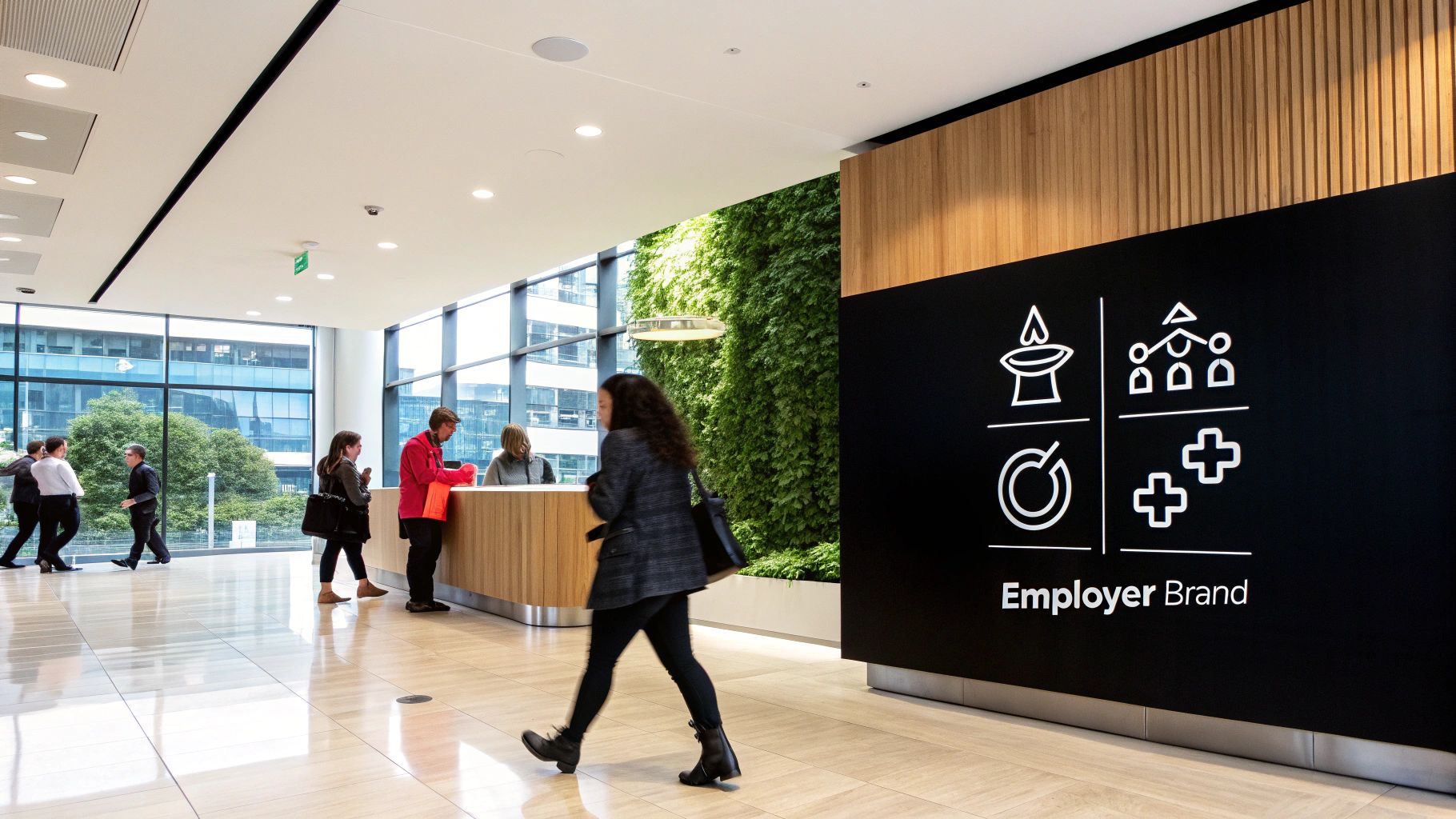Level Up Your Hiring Game
Want to attract and secure top talent? This listicle delivers seven best practices in recruitment to elevate your hiring process. Learn how to build a data-driven recruitment strategy, optimize the candidate experience, implement structured interviews, and develop a strong employer brand. We'll also explore diversity, equity, and inclusion (DEI) in recruitment, building talent pipelines, and skills-based hiring. These best practices empower you to find the right candidates and build a winning team. Let's get started!
1. Data-Driven Recruitment Strategy
In today's competitive talent landscape, recruitment is no longer about gut feelings and guesswork. It's about making smart, strategic decisions backed by concrete data. A data-driven recruitment strategy empowers you to optimize every stage of your hiring process, from initial sourcing to final offer, leading to better hires, faster time-to-fill, and a significant boost to your bottom line. This methodical approach leverages metrics and analytics to identify trends, predict outcomes, and make informed decisions, transforming your recruitment function into a well-oiled, predictable engine of talent acquisition.

This approach involves meticulously collecting, analyzing, and interpreting recruitment data to gain actionable insights. This might include tracking key metrics such as time-to-hire, cost-per-hire, and quality of hire, using predictive analytics to gauge candidate success, A/B testing various recruitment channels to understand their effectiveness, continuously evaluating the performance of your recruitment strategies, and diving deep into pipeline analytics to identify bottlenecks and opportunities.
Features of a Data-Driven Recruitment Strategy:
- Metrics Tracking: Monitor crucial metrics like time-to-hire, cost-per-hire, and quality of hire to identify areas for improvement.
- Predictive Analytics: Leverage data to forecast which candidates are most likely to succeed and contribute to your organization.
- A/B Testing: Experiment with different recruitment channels and messaging to determine the most effective strategies.
- Continuous Performance Evaluation: Regularly assess the effectiveness of your recruitment efforts and make adjustments as needed.
- Pipeline Analytics: Analyze your candidate pipeline to identify bottlenecks, optimize your process, and ensure a steady flow of qualified applicants.
Why This Approach Deserves Its Place in the List:
Data-driven recruitment is no longer a "nice-to-have" but a "must-have" for any organization serious about attracting and retaining top talent. It provides the foundation for objective decision-making, removing bias and promoting fairness in the hiring process. This approach also allows you to measure the effectiveness of your recruitment spend, ensuring maximum ROI.
Pros:
- Reduces Hiring Bias: Objective measurements replace subjective opinions, leading to fairer and more equitable hiring decisions.
- Improves ROI on Recruitment Spending: Data-driven insights help you optimize your recruitment budget and maximize your return on investment.
- Enables Continuous Improvement: Actionable insights allow you to continually refine your strategies and improve your hiring outcomes.
- Identifies Most Effective Sourcing Channels: Data reveals which channels are delivering the highest quality candidates, allowing you to focus your efforts where they matter most.
- Allows for Better Workforce Planning: Data-driven insights provide a clearer picture of your future talent needs, enabling proactive workforce planning.
Cons:
- Requires Investment in Analytics Tools: Implementing a data-driven approach may require investment in specialized software and platforms.
- Needs Dedicated Data Analysis Expertise: Interpreting and acting upon data effectively requires skilled analysts.
- May Overlook Qualitative Factors: Over-reliance on data can sometimes overshadow important qualitative factors, such as cultural fit.
- Data Privacy Concerns: Collecting and managing candidate data responsibly requires careful consideration of privacy regulations.
- Time Investment for Meaningful Datasets: Building robust datasets takes time and consistent effort.
Examples of Successful Implementation:
- Google's People Analytics team: Uses data to predict which candidates are most likely to be successful, improving hiring outcomes.
- IBM's AI-powered recruiting platform: Analyzes success patterns of current employees to identify ideal candidate profiles.
- Unilever's digital assessment tools: Streamlined the application process and reduced time-to-hire by a remarkable 90%.
Actionable Tips:
- Start Small: Begin by tracking 3-5 key metrics aligned with your business goals.
- Integrate Your ATS: Connect your Applicant Tracking System with analytics platforms for seamless data collection.
- Establish Benchmarks: Set baseline metrics before implementing any major changes to measure progress accurately.
- Share Insights: Regularly communicate data-driven insights with hiring managers and leadership.
- Balance Quantitative and Qualitative: Combine data-driven insights with qualitative feedback for a holistic understanding of candidates.
By embracing a data-driven recruitment strategy, you can transform your hiring process from a reactive scramble into a proactive, predictable, and highly effective talent acquisition machine. This approach empowers you to make informed decisions, attract top talent, and build a high-performing workforce that drives organizational success.
2. Candidate Experience Optimization
In today's competitive talent market, attracting and retaining top talent is paramount. Candidate Experience Optimization is no longer a "nice-to-have" but a critical component of best practices in recruitment. It's a comprehensive approach to elevating every interaction a potential employee has with your organization, transforming the often-stressful job search into a positive and engaging journey. This strategy positions candidates as valued individuals, much like cherished customers, regardless of whether they receive a job offer. This approach recognizes that every touchpoint, from the initial application to onboarding (and even rejection), shapes a candidate’s perception of your brand.

Candidate Experience Optimization works by meticulously designing each stage of the recruitment process with the candidate in mind. This includes streamlining applications, providing transparent communication about timelines and next steps, personalizing interactions, offering consistent feedback, and ensuring mobile-friendly application platforms. Imagine a process so seamless and respectful that even rejected candidates walk away with a positive impression of your organization – that’s the power of Candidate Experience Optimization.
Features of an Optimized Candidate Experience:
- Streamlined Applications: Say goodbye to lengthy, cumbersome application forms. An optimized process is quick, easy, and respects the candidate’s time.
- Transparent Communication: Keep candidates informed about their application status, expected timelines, and the overall hiring process. Eliminate the guesswork and anxiety.
- Personalized Interactions: Tailor your communication to each individual, acknowledging their unique skills and experience. Show them you see them as more than just a resume.
- Consistent Feedback Mechanisms: Provide constructive feedback at each stage, whether it’s an interview debrief or a post-rejection explanation. This fosters respect and helps candidates grow.
- Mobile-Optimized Platforms: Recognize that many candidates apply via mobile devices. Ensure your application process is accessible and user-friendly on any platform.
Why Prioritize Candidate Experience? (The Pros)
- Increased Candidate Conversion Rates: A positive experience encourages qualified candidates to complete the process and accept offers.
- Positive Employer Brand Reputation: Happy candidates become brand ambassadors, spreading positive word-of-mouth and enhancing your employer brand.
- Robust Talent Pipeline: Even rejected candidates can become future applicants or refer others if they’ve had a good experience.
- Reduced Ghosting and Dropouts: Clear communication and a respectful process minimize candidate drop-off rates.
- Turning Rejected Candidates into Brand Advocates: A positive experience, even in rejection, can turn a negative into a valuable networking opportunity.
Challenges of Implementation (The Cons)
- Resource Intensive: Maintaining high-touch processes requires dedicated resources and time.
- Scalability Issues: Implementing personalized experiences can be challenging for high-volume recruiting.
- Unrealistic Expectations: Overly polished experiences may create expectations that are difficult to sustain long-term.
- Difficult ROI Measurement: Quantifying the return on investment for candidate experience can be complex.
- Cross-Departmental Buy-in: Success requires buy-in and collaboration from all stakeholders involved in the hiring process.
Examples of Excellence:
- Airbnb: Provides personalized travel guides to candidates visiting their offices, demonstrating genuine care and hospitality.
- Zappos: Offers a "no resume" application option and prioritizes cultural fit conversations, showcasing their unique company values.
- Salesforce: Provides transparent "What to Expect" guides for different interview stages, reducing candidate anxiety and setting clear expectations.
Actionable Tips for Implementing Candidate Experience Optimization:
- Candidate Journey Audit: Step into the shoes of a candidate and experience your application process firsthand. Identify pain points and areas for improvement.
- Automated yet Personalized Communication: Utilize automation tools to send personalized messages at key stages, such as application acknowledgement, interview confirmations, and feedback delivery.
- Candidate Feedback Collection: Gather feedback through surveys and actively use it to refine your processes.
- Interviewer Training: Train all interviewers on candidate experience best practices, emphasizing empathy, respect, and clear communication.
- Expectation-Setting Materials: Create clear and concise materials outlining expectations for each role and stage of the hiring process.
Who’s Leading the Charge?
The importance of candidate experience has been championed by organizations like the Talent Board, creators of the Candidate Experience Awards, and influential figures like Richard Branson (Virgin Group) and Kevin Grossman (Talent Board President). These individuals and organizations recognize that investing in candidate experience is investing in the future of your organization.
By prioritizing Candidate Experience Optimization, you're not just filling open positions; you're building a strong employer brand, cultivating a talent pipeline, and creating a positive impact on the lives of every individual who interacts with your organization. This is why it deserves its place amongst the best practices in recruitment.
3. Structured Interview Process
Want to revolutionize your recruitment process and make genuinely data-driven hiring decisions? A structured interview process is a crucial best practice in recruitment that can significantly elevate your hiring game. This evidence-based methodology brings consistency and fairness to candidate evaluation, enabling you to identify top talent more effectively. It involves asking all candidates for the same position identical questions in the same order and evaluating their responses against a pre-defined set of criteria. This approach dramatically reduces unconscious bias and increases the predictive validity of your hiring decisions, ultimately leading to a stronger, more successful workforce.

A structured interview process is built on several key features: predetermined questions directly linked to essential job competencies, standardized evaluation criteria with clear rating scales, consistent format and question sequencing, the use of job-relevant scenarios and behavioral questions, and frequently, the involvement of multiple interviewers or diverse interview panels. By standardizing these elements, you create a level playing field for all candidates, allowing their skills and experience to truly shine.
This approach offers numerous advantages. It significantly reduces unconscious bias, a common pitfall in traditional interviewing. It improves the prediction of on-the-job performance by focusing on relevant competencies. Furthermore, it creates defensible hiring decisions with clear documentation, enhancing legal compliance. Finally, it enables a truly meaningful comparison between candidates, making the selection process more objective and efficient.
Of course, no system is perfect. Structured interviews can sometimes feel rigid or impersonal to candidates. They also require substantial upfront preparation and thorough interviewer training. There's a risk of limiting the exploration of unexpected but valuable candidate qualities that might emerge in a less structured conversation. Implementing this approach consistently across diverse roles can also be challenging and takes more time to design initially.
However, the benefits far outweigh the challenges. Companies like Google, with their standardized behavioral and situational interview framework, and McKinsey, with its case-based interview process and standardized evaluation criteria, exemplify the success of structured interviews. Even the U.S. military utilizes structured assessment centers for officer selection, demonstrating the power of this methodology across diverse industries.
Ready to implement this best practice in your own recruitment process? Here are some actionable tips:
- Create question banks tied to specific job competencies: Ensure every question assesses a relevant skill or trait.
- Develop clear scoring rubrics with behavioral anchors: Define what constitutes a strong, average, or weak response for each question.
- Train interviewers thoroughly and refresh training regularly: Consistency in execution is key.
- Balance structure with rapport-building moments: While maintaining structure, allow for natural conversation to create a positive candidate experience.
- Update questions periodically based on effectiveness data: Continuously refine your process based on real-world outcomes.
By embracing a structured interview process, you are not just following a trend; you are investing in a scientifically-backed methodology championed by industrial-organizational psychologists and popularized by figures like Laszlo Bock, former Google HR chief. You're also leveraging the capabilities of advanced HR technology platforms like Workday. This commitment to best practices will transform your recruitment process, leading to better hires, improved team performance, and a more successful organization overall. This is undoubtedly a key ingredient for elevating your recruitment strategy and achieving hiring excellence.
4. Employer Branding and EVP Development
In today's competitive talent landscape, attracting top-tier candidates requires more than just posting open positions. It demands a strategic approach to showcasing your organization's unique identity and value as an employer. This is where employer branding and EVP development become crucial best practices in recruitment. Employer branding is the ongoing process of defining, communicating, and maintaining your organization's persona as an employer. It's about crafting a compelling narrative that resonates with your ideal candidates and sets you apart from the competition. At the heart of this process lies the Employee Value Proposition (EVP), which articulates the unique benefits and experiences employees gain by joining your team. It answers the critical question: "Why should someone choose to work here?"

A strong employer brand, driven by a well-defined EVP, acts as a magnet for talent. It helps attract candidates who are not only skilled but also culturally aligned with your organization, leading to improved retention and higher employee satisfaction. This approach moves beyond simply filling roles; it’s about building a thriving workforce that contributes to long-term organizational success.
Features of Effective Employer Branding and EVP Development:
- Clearly Articulated EVP: A concise and compelling statement that encapsulates the essence of what your company offers employees.
- Authentic Representation of Workplace Culture: Honest portrayal of the day-to-day work environment, values, and employee experiences.
- Consistent Messaging Across All Recruitment Channels: Ensuring a unified brand voice and message from your career site to social media platforms.
- Employee Advocacy Programs and Testimonials: Empowering current employees to share their positive experiences and become brand ambassadors.
- Career Site and Social Media Optimization: Leveraging digital platforms to showcase your employer brand and engage with potential candidates.
Pros:
- Attracts Candidates Aligned with Organizational Values: Leading to higher quality hires and improved cultural fit.
- Reduces Cost-Per-Hire Through Inbound Recruiting: By attracting candidates organically, reducing reliance on expensive recruitment agencies.
- Increases Offer Acceptance Rates: A compelling EVP can sway candidates in your favor.
- Improves Retention of New Hires: Setting realistic expectations from the outset minimizes disillusionment and early departures.
- Differentiates From Competitors: Especially crucial in tight talent markets where standing out is essential.
Cons:
- Requires Significant Long-Term Investment: Building a strong employer brand takes time and dedicated resources.
- Must Be Authentic or Risks Creating Disillusionment: False promises can damage your reputation and lead to employee distrust.
- Difficult to Measure Direct ROI: While the benefits are significant, quantifying the exact return can be challenging.
- Needs Ongoing Maintenance and Evolution: Your employer brand should adapt as your organization grows and changes.
- Can Be Challenging to Align Across Diverse Business Units: Maintaining consistency across different departments requires careful planning and communication.
Examples of Successful Implementation:
- Salesforce: Their "#SalesforceOhana" culture emphasizes family and community, combined with their 1-1-1 philanthropy model, creating a powerful draw for purpose-driven individuals.
- Patagonia: Integrates its commitment to environmental activism into its employer brand, attracting candidates passionate about sustainability.
- HubSpot: Their Culture Code slide deck, which went viral, transparently showcased their values and work environment, making them an attractive employer for many.
Actionable Tips:
- Conduct Research: Engage with current employees to identify authentic differentiators and understand their experiences.
- Segment Your EVP: Tailor your messaging for specific talent pools if necessary.
- Empower Employee Ambassadors: Equip your team to share their positive experiences on social media.
- Ensure Authenticity: Make sure your recruitment marketing materials accurately reflect your workplace.
- Regular Audits: Regularly review and refresh content on review sites like Glassdoor to maintain a positive online presence.
Why Employer Branding Deserves Its Place on the List:
In the modern recruitment landscape, employer branding and EVP development are no longer optional; they are essential. They provide a powerful framework for attracting, engaging, and retaining top talent. By investing in a strong employer brand, you are investing in the future success of your organization. This approach, popularized by thought leaders like Simon Sinek and championed by platforms like LinkedIn, empowers you to build a thriving workforce and achieve sustainable growth. By making employer branding a core component of your recruitment strategy, you will not only attract top-tier candidates but also build a stronger, more engaged, and ultimately more successful organization.
5. Diversity, Equity and Inclusion (DEI) Recruitment
Diversity, Equity, and Inclusion (DEI) recruitment isn't just a trend; it's a transformative approach to building a workforce that reflects the rich tapestry of our world. It's a vital best practice in recruitment, moving beyond simply filling roles to actively cultivating a vibrant and representative workforce. By weaving DEI principles into every step of your hiring process, you're not only building stronger teams but also fostering a more equitable and inclusive workplace culture. This directly impacts your ability to attract top talent, foster innovation, and drive better business outcomes. That's why it deserves a prominent place in any discussion of best practices in recruitment.
What is DEI Recruitment and How Does it Work?
DEI recruitment is a strategic method focused on attracting, hiring, and retaining diverse talent. It goes beyond legal compliance to proactively address systemic biases and barriers that can prevent qualified candidates from underrepresented groups from accessing opportunities. It involves implementing equitable hiring practices that mitigate bias at every stage, from crafting inclusive job descriptions to ensuring diverse interview panels.
Features of DEI Recruitment:
- Diverse Candidate Slate Requirements: Mandating a diverse pool of candidates for every open role ensures consideration of talent from a variety of backgrounds.
- Bias-Mitigating Language in Job Descriptions: Using inclusive language and removing gendered or culturally biased terms can significantly broaden the appeal of your job postings.
- Partnerships with Diversity-Focused Organizations: Collaborating with organizations like Code2040 or similar groups focused on specific underrepresented groups can connect you with a rich pipeline of qualified candidates.
- Blind Resume Screening Practices: Removing identifying information from resumes during initial reviews can help mitigate unconscious bias related to names, schools, or other demographics.
- Diverse Interview Panels: Including interviewers from different backgrounds and departments provides a more holistic assessment of candidates and fosters a sense of inclusivity from the start.
Pros:
- Expands Talent Pool: Unlocks access to previously overlooked talent, bringing fresh perspectives and skills to your organization.
- Innovation and Problem-Solving: Diverse teams are proven to be more innovative and effective at problem-solving due to a wider range of experiences and perspectives.
- Enhanced Company Reputation: Demonstrates a commitment to social responsibility, attracting values-aligned talent and strengthening your employer brand.
- Equitable Workplace Representation: Creates a more just and representative workplace that reflects the diversity of your customer base and the wider community.
- Improved Business Outcomes: Diversity of thought leads to better decision-making, increased creativity, and ultimately, stronger business results.
Cons:
- Long-Term Commitment: Requires sustained effort and resources to see meaningful and lasting change.
- Potential Resistance: May encounter resistance from those accustomed to the status quo.
- Investment in Training and Systems: Necessitates investment in training, tools, and system changes to support DEI initiatives effectively.
- Metrics and Tracking: Defining and tracking meaningful DEI metrics can be complex.
- Risk of Tokenism: Requires authentic implementation to avoid superficial gestures rather than true inclusion.
Examples of Successful Implementation:
- Slack's Partnership with Code2040: Provides engineering internships to Black and Latinx students, building a pipeline of diverse tech talent.
- Intel's Investment in Diversity Initiatives: Intel's $300 million investment demonstrates a significant financial commitment to driving diversity within their workforce.
- Accenture's Use of AI Tools: Leveraging AI to identify and remove bias from job descriptions ensures more inclusive language and broader applicant reach.
Actionable Tips for Implementing DEI Recruitment:
- Audit for Bias: Conduct a thorough review of your current recruitment process to identify areas of potential bias.
- Set Measurable Goals: Establish specific, measurable, achievable, relevant, and time-bound (SMART) goals for diverse representation.
- Expand Sourcing Channels: Utilize targeted diversity networks and job boards to reach underrepresented candidates.
- Unconscious Bias Training: Provide training for recruiters and hiring managers on unconscious bias and its impact on hiring decisions.
- Standardized Evaluation Criteria: Develop standardized evaluation criteria to ensure objective assessment of candidates' qualifications.
Why DEI Recruitment is Essential:
In today's globalized and interconnected world, embracing diversity is no longer just a good idea—it's a business imperative. DEI recruitment is not simply about ticking boxes; it's about building a thriving organization that harnesses the power of diverse perspectives, experiences, and backgrounds. By prioritizing DEI in your recruitment efforts, you are investing in the future of your organization and contributing to a more just and equitable world. Inspirational leaders and organizations like Project Include (founded by Ellen Pao), Paradigm (DEI consulting firm), and Dr. Stefanie K. Johnson (author of Inclusify) champion this approach, highlighting its critical role in creating a more inclusive and representative workforce. Embracing DEI recruitment is an investment in a future where everyone has the opportunity to thrive.
6. Talent Pipeline Development: Build Your Dream Team Before You Need It
In today's competitive talent landscape, reactive recruitment simply isn't enough. Enter talent pipeline development, a proactive and strategic approach to best practices in recruitment that empowers you to build relationships with top-tier candidates before you have open roles. Imagine having a pool of pre-qualified, engaged individuals ready to step in when a need arises – that's the power of a robust talent pipeline. This forward-thinking strategy not only drastically reduces time-to-hire but also significantly improves the quality of your hires, ensuring you're always one step ahead.
How it Works: From Passive Interest to Active Engagement
Talent pipeline development involves identifying, attracting, and nurturing potential candidates long before a specific job opening exists. Think of it as cultivating a fertile ground of talent, ready to bloom when the right opportunity arises. This involves utilizing various tools and strategies, such as:
- Talent Community Platforms and CRM Systems: These platforms act as central hubs for managing and engaging your talent pool.
- Proactive Sourcing for Critical Roles: Don't wait for candidates to come to you; actively seek out top talent for roles you know will be crucial.
- Nurture Campaigns for Passive Candidates: Keep warm leads engaged with targeted content and communication.
- Silver Medalist Programs for Previous Finalists: Don't let great candidates slip away. Maintain relationships with strong contenders who didn't quite make the cut for previous roles.
- Internal Talent Marketplace Development: Unlock hidden potential within your existing workforce by creating opportunities for internal mobility and skill development.
Real-World Success Stories:
Companies like Johnson & Johnson, Cisco, and Amazon have embraced talent pipeline development with impressive results. Johnson & Johnson's J&J Discover platform connects with potential scientists and researchers, while Cisco's Military Talent Incubator program builds a pipeline of veterans. Amazon's 'Keep In Touch' program ensures they maintain relationships with declined candidates, recognizing their potential future value. These examples demonstrate the tangible benefits of proactive talent engagement.
Actionable Tips to Build Your Own Pipeline:
- Identify Critical Roles: Start by focusing on roles that are frequently open or notoriously difficult to fill.
- Segment Your Talent Pools: Organize your pipeline by skills, experience level, and interests to enable targeted communication.
- Create Value-Adding Content: Share insightful articles, industry news, and company updates to keep your pipeline engaged and informed.
- Schedule Regular Touchpoints: Set calendar reminders to connect with high-value prospects, demonstrating your ongoing interest.
- Partner with Educational Institutions: Build relationships with universities and colleges to create a pipeline of entry-level talent.
Why Talent Pipeline Development Deserves a Spot in Best Practices in Recruitment:
In a world where top talent is in high demand, talent pipeline development offers a significant competitive advantage. By proactively building relationships, you're not just filling roles; you're building a future-ready workforce. This strategy shifts the recruitment paradigm from reactive scrambling to strategic preparation, ensuring you have the right people in place to drive your organization's success.
Pros and Cons at a Glance:
Pros:
- Drastically reduces time-to-fill for critical positions
- Decreases dependency on reactive job board posting
- Improves quality of hire through pre-vetted candidates
- Creates competitive advantage in tight labor markets
- Reduces overall recruitment costs long-term
Cons:
- Requires upfront investment with delayed return
- Needs sophisticated CRM tools and processes
- Demands consistent engagement to maintain pipeline interest
- Can be challenging to measure effectiveness
- Requires recruiter skill shift from transactional to relationship-based
Talent pipeline development, championed by thought leaders like Lou Adler and implemented by giants like GE and IBM, is no longer a cutting-edge trend; it's a core component of best practices in recruitment. By embracing this proactive approach, you'll not only secure top talent but also build a dynamic and resilient workforce ready to tackle the challenges of tomorrow.
7. Skills-Based Hiring: Unlock Hidden Talent and Revolutionize Your Recruitment
In today's rapidly evolving job market, clinging to outdated recruitment practices can mean missing out on exceptional talent. One of the most impactful best practices in recruitment is skills-based hiring, a revolutionary approach that prioritizes a candidate's demonstrated abilities over traditional credentials like degrees or past job titles. This method allows you to unlock a wider pool of talent and build a more diverse and skilled workforce. Forget the proxies; skills-based hiring focuses on what truly matters: can a candidate do the job?
How it Works:
Skills-based hiring flips the traditional recruitment script. Instead of filtering resumes based on degrees and years of experience, it assesses candidates based on their actual abilities. This is achieved through a variety of methods:
- Job-relevant skills assessments and work samples: Candidates are presented with tasks that mirror the actual work they’ll be doing. This gives you a direct measure of their competency.
- Competency frameworks for evaluation: These frameworks provide a structured approach to evaluating specific skills, ensuring consistency and fairness throughout the process.
- Technical challenges and simulations: These are particularly useful for technical roles, allowing candidates to showcase their coding, design, or problem-solving abilities in a realistic environment.
- Portfolio-based evaluation: For creative or project-based roles, portfolios offer a tangible demonstration of a candidate's skills and experience.
- Focus on transferable skills across industries: This recognizes the value of skills acquired in different contexts, opening doors for candidates with diverse backgrounds.
Examples of Success:
Several organizations have embraced skills-based hiring with impressive results:
- IBM's 'New Collar Jobs' initiative: By focusing on skills over degrees, IBM has opened opportunities for individuals from non-traditional backgrounds to thrive in tech roles.
- Google's coding challenges: These assessments provide a direct measure of a candidate's coding proficiency, ensuring they have the skills needed to succeed in demanding engineering roles.
- Gitlab's asynchronous project-based interviews: These allow candidates to demonstrate their skills in a realistic work environment, providing valuable insights into their abilities and work style.
Why Skills-Based Hiring Deserves its Place in the List of Best Practices:
This approach directly addresses some of the biggest challenges in modern recruitment, including bias, skills gaps, and a limited talent pool. It's a powerful tool for building a more inclusive, diverse, and ultimately more successful workforce.
Pros and Cons:
While skills-based hiring offers numerous benefits, it's crucial to acknowledge the challenges:
Pros:
- Expands the talent pool beyond traditional credential barriers
- Improves prediction of on-the-job performance
- Reduces bias associated with prestige hiring
- Increases diversity by removing arbitrary barriers
- Helps identify candidates with growth potential
Cons:
- Can be difficult to design valid assessments
- May increase initial screening time and complexity
- Requires retraining of recruiters and hiring managers
- Sometimes meets resistance from traditional hiring stakeholders
- Challenges in evaluating soft skills objectively
Actionable Tips for Implementation:
- Start small: Begin with roles where skills can be clearly defined and measured.
- Mirror reality: Design assessments that mirror actual job tasks.
- Validate your assessments: Compare assessment scores to on-job performance to ensure they are predictive of success.
- Remove degree requirements: Eliminate degree requirements from job descriptions when not legally required.
- Train your team: Equip hiring managers to evaluate candidates based on demonstrated skill evidence.
When and Why to Use This Approach:
Skills-based hiring is particularly valuable when:
- Facing a skills shortage: When traditional recruitment methods fail to yield qualified candidates.
- Seeking diverse talent: To break down barriers and access a wider pool of potential employees.
- Prioritizing performance: When on-the-job performance is the ultimate measure of success.
By embracing skills-based hiring, you can transform your recruitment process, attract top talent, and build a workforce ready to thrive in the future of work. It’s not just about filling roles; it’s about investing in potential and empowering individuals to succeed based on their true abilities. Inspired by the work of individuals like Byron Auguste of Opportunity@Work and former IBM CEO Ginni Rometty, as well as platforms like Coursera and Udacity, skills-based hiring is paving the way for a more equitable and skills-driven future.
7 Best Practices Comparison Guide
| Best Practice | Implementation Complexity 🔄 | Resource Requirements ⚡ | Expected Outcomes 📊 | Ideal Use Cases 💡 | Key Advantages ⭐ |
|---|---|---|---|---|---|
| Data-Driven Recruitment Strategy | High – requires analytics tools & expertise | Significant – analytics platforms and data analysts | Improved hiring quality, reduced bias, better workforce planning | Organizations with volume hiring & data maturity | Objective decisions, continuous improvement, ROI focus |
| Candidate Experience Optimization | Medium to High – needs process redesign & personalization | High – communication platforms & dedicated teams | Higher candidate conversion, stronger employer brand | Customer-centric employers, competitive talent markets | Improved candidate engagement, reduced dropouts, brand advocates |
| Structured Interview Process | Medium – requires training & standard design | Medium – interviewer training and materials | Fair, unbiased hiring, defensible decisions | Roles where fair assessment & legal compliance critical | Reduces bias, improves performance prediction, fairness |
| Employer Branding and EVP Development | High – ongoing strategy & alignment | High – marketing, employee programs, and content creation | Better talent attraction, higher retention | Companies differentiating in tight talent markets | Attracts values-aligned candidates, lowers hiring costs |
| Diversity, Equity and Inclusion (DEI) Recruitment | Medium to High – requires cultural and process changes | Medium to High – training, diverse panels, partnerships | More diverse, innovative teams, improved reputation | Organizations prioritizing equitable hiring practices | Expands talent pool, reduces bias, drives innovation |
| Talent Pipeline Development | Medium – needs CRM, nurturing strategy | Medium to High – CRM tools & continuous engagement | Faster hiring, higher quality candidates | Critical or recurring hires, tight labor markets | Reduces time-to-fill, cost-effective long-term, strategic |
| Skills-Based Hiring | Medium – assessment design & training | Medium – skills tests, evaluation frameworks | Better job fit, reduced credential bias | Technical & growth-potential-focused roles | Expands talent pool, increases diversity, predicts performance |
Ready to Recruit the Best?
From data-driven strategies to DEI initiatives and skills-based hiring, mastering the best practices in recruitment outlined in this article is paramount to building a thriving organization. We've explored the importance of optimizing the candidate experience, structuring your interview process, building a strong employer brand and EVP, developing diverse talent pipelines, and embracing skills-based assessments. By focusing on these core areas, you are not just filling open positions; you are strategically building a high-performing team ready to tackle future challenges.
Remember, attracting top-tier talent is only half the battle. To truly maximize your ROI, you also need to retain those valuable employees. To attract and retain top talent, it's essential to implement effective strategies that foster a positive work environment, promote growth opportunities, and recognize employee contributions. Learn more about proven employee retention strategies.
Implementing these best practices in recruitment requires a deep understanding of the evolving talent landscape. This is where the Global Human Resource Institute comes into play. Their specialized certifications like HRQP, HRAP, and HRCE provide you with cutting-edge knowledge and skills in modern recruitment strategies, empowering you to become a true talent magnet. By taking these steps and leveraging these resources, you can create a robust recruitment process that consistently brings in the best and brightest. Elevate your recruitment game and build a world-class team – explore the Global Human Resource Institute today and discover the power of effective recruitment.




0 Comments